by tmoffett | Jun 5, 2012 | Color, Landscape
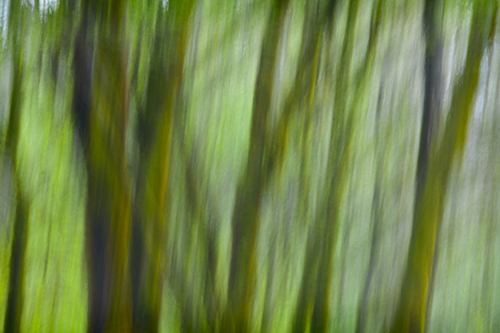
Trees at Dusk, Columbia River Gorge
After photographing waves on the ocean for four days and then waterfalls all afternoon, my whole mindset was motion. When looking at the trees, in my minds eye I could see their branches and leaves blowing in the breeze. The trouble was that there was no breeze! To get the look that I visualized, I moved the camera, creating the appearance of motion. I teach a unit at school in my advanced class on implied motion. I do not use the technique very often, but in this situation it worked perfectly.
My photography is not so much exploratory anymore, it is about creating images of my vision. I will explore whatever technique is needed for that purpose. I prefer to find my vision and then photograph rather than photograph to find my vision. For me, it is much powerful and rewarding that way.
by tmoffett | May 29, 2012 | Color, Landscape, Photographic Technique
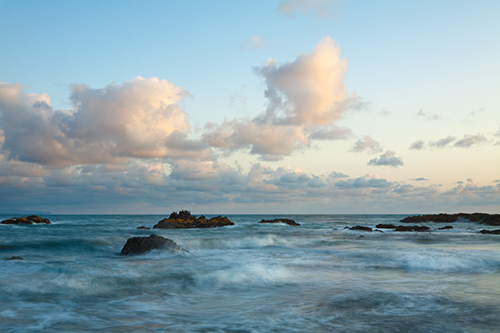
View from Cobble Beach, Newport, Oregon
I don’t know why, but I am really drawn to the water. Any water. Rivers. Streams. Lakes. But mostly the ocean. I am in the middle of giving final exams in my classes and I am really wishing I was at the beach with my camera instead. It doesn’t help matters that everywhere I turn I have photographs reminding me of how much I enjoy the coast.
One reason, I think, that I enjoy photographing moving water so much is the variety that it offers. You can stop the waves and capture every droplet of water as it sprays toward the shore, you can slow things down and capture the flow of the water over the rocks, or you can go anywhere in between. What I am feeling at the time usually dictates how I see the water and how I will photograph it. I often teach, especially in my beginner courses, to experiment with different exposure settings to see what happens to the image. I rarely do much experimenting when out photographing. I see what I see, my vision, and that is what I photograph. In earlier days I did the experimenting. I learned what happens when I use a long shutter speed. I learned how fast I needed to shoot to stop the water in a fast-flowing river. Now I spend more time experiencing the scene and then photographing it the way I feel it to be. The techniques have become my tools. I use these tools to create images resembling my vision. The tools enhance my creativity.
This particular evening at Cobble Beach, I met the Park Ranger as I was descending the steps to the beach. I was informed that I must be off the beach 10 minutes before sunset and out of the park 10 minutes after sunset. This threw a damper in my plans, as I love photographing long after the sun goes down. I felt rushed to get what I wanted, and upon reviewing my photographs from that evening, I think it affected me. Instead of creating soft, flowing images of a relatively smooth sea, I found myself using an “in between” shutter speed that would enhance the waves and make the scene appear more turbulent than maybe it really was. All of my exposures showed that look and feel. It was definitely different than what I shot the rest of that trip. It was proof to me that my emotions do affect the way I see, and therefore the way I photograph. I like it that way!
by tmoffett | May 22, 2012 | Color, Landscape, Photographic Philosophy, Photographic Technique
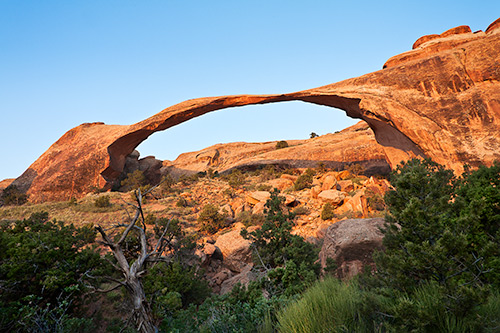
Landscape Arch, Arches National Park
My life can get quite crazy when on a photography trip. I arise early, oftentimes 4:00 A.M. or earlier and head out to a predetermined location. Frequently a pre-dawn hike is required and I arrive in plenty of time to prepare for sunrise. I never like to be rushed. Photography for me is not a job, it is an experience, and one to be enjoyed! Once I arrive at a location, I try never to hurry, I observe, I meditate, I let all of my senses go to work so that I can fully experience where I am. Only after I find myself can I really create an image that will have any impact at all. Once I have determined what it is that I will photograph and how I will photograph it, I set up and wait. As the sun nears the horizon, the light quality gets better and better, then all at once it becomes great! I shoot away, making subtle adjustments between exposures until everything is just right, then nearly as quickly as it came, the light is gone. Sometimes in the morning, the real good light only lasts a few short minutes, then it becomes harsh and uncontrollable. All of this effort for sometimes a mere five minutes of great light. Worth it? Absolutely! So much so that I turn around and do the same thing in the evening.
Evening photography is a little different than sunrise photography. The light quality stays good for me longer in the evening than in the morning, mostly because I love the light after the sun sets. I often, during the summer months, will shoot until after 10:00. This makes for some really short nights, but very much worth it in my opinion. I do need a few days to recover after returning home from a photography “vacation.” Why do I do it? It is who I am. I love photography, and great photographs are made at the ends of the day. I once heard a friend respond to someone questioning why it was necessary to get up so early. His response was that “At five o’clock you’re a photographer but at 11:00 you’re just another tourist.” How true that is. Avoiding tourists and enjoying the sights in a kind of light that you will never find at mid-day is part of what drives this passion of mine.
by tmoffett | May 15, 2012 | Color, Composition, Landscape, Photographic Philosophy
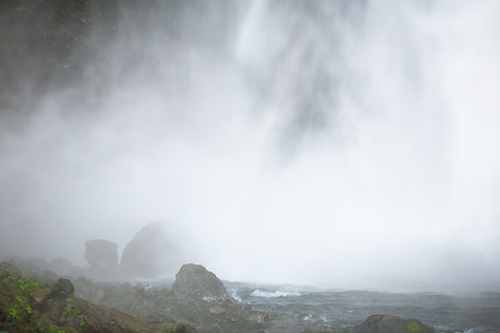
Impact Zone, Multnomah Falls
When traveling to the Northern Oregon Coast I will frequently stop at Multnomah Falls, a very popular and spectacular waterfall that is right next to the highway. I find it interesting that even though I have stopped and photographed this waterfall on numerous occasions, I have never printed an image of the entire falls. I am, for some reason, drawn to the details of this amazing display of water power. This past trip through the Columbia River Gorge was no different. I hiked up to the bridge that provides a great view of impact zone, the area where the falling water meets the pool below. It was fascinating to me. I stood watching as the spray of cold water soaked me and my gear to the bone. I realized what it was I needed to photograph. The trouble was figuring out how to keep my lens dry enough to get the image.
I set up my camera on the tripod and, not worrying at first about getting wet, framed up the image. I needed to capture the falling water at the edge of the frame with the spray and mist blowing through the frame to the left side, causing a thick haze across the entire frame. After framing it up and calculating the needed exposure to show the texture of the falling water in the background and create the desired haze in the foreground, I dried the lens and, with the help of my wife, kept the lens covered until just prior to tripping the shutter, then immediately after the exposure, covered the lens again. About every third shot, I stopped to dry off the lens again. It was quite a challenging process, however very rewarding as well.
Masterpieces are very rarely created in an easy setting. I believe that it is the challenges that allow us to create great images. In photography, just as it is in life, anything worth doing is worth working for. In conditions where everyone else packs it in and goes home, he who perseveres is bound to create something great. It is that challenge that I am constantly striving for. That is one reason that when I saw the forecast for heavy rain I opted to go to the coast. I knew that the adverse conditions would force me to look at things a little differently than I had in the past. I would attack the situation head on and was confident that I could win. I certainly was glad that I did as I returned home with a few great images added to my portfolio.
by tmoffett | May 10, 2012 | Color, Landscape
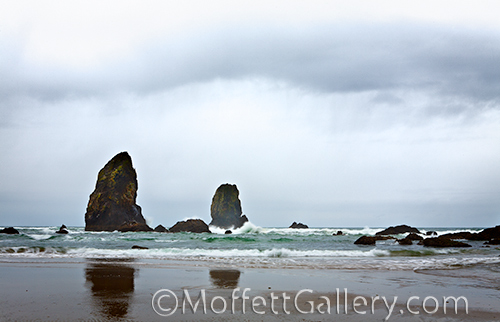
Rainstorm at the Needles
I can’t say that I love cold and rainy weather, but I do love how a good storm can create a mood. Last week as I was on the Oregon Coast, we had rain every day, and it wasn’t Idaho rain, this was real rain. It was tempting at times not to go out in the elements, as I was on a relaxing vacation, not really a working photography trip. However, every time I had the thought to stay in, thoughts of the different look I could get if I ventured out entered my mind and I was easily persuaded to photograph in the rain. I am very glad I did, as I was able to add a few images to my Oregon portfolio that have a much different feel to them than those that I had previously made.
When photographing in adverse conditions, it is so important to really have a command of the medium. Knowing what effect different shutter speeds will have on an image when the rain is coming down and the wind blowing is really not something that you want to have to think about. By the time you have thought about it, it is too late. The whole scene may have changed. I want to be able to quickly evaluate a scene and make fast decisions as to how to capture the feeling that I want to portray, set the camera and move on. In these situations I was fortunate to have my wife with me as an assistant, holding an umbrella or doing whatever was necessary to keep my equipment as dry as possible. This is not an easy task when the rain is blowing horizontally, but she did a fantastic job. I focused on making images while she focused on keeping us dry. It was a great combination that allowed me to make a few wonderful images.
by tmoffett | May 8, 2012 | Color, Landscape
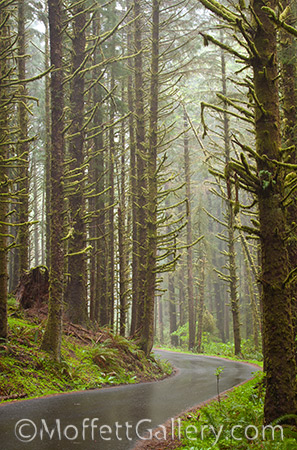
Rainstorm, Ecola State Park
It is always good to be back home. After a 5 day trip to the Oregon Coast, we arrived home yesterday. I love Oregon. It is one of my favorite places to travel to and photograph. However, as much as I love Oregon, Idaho is my home, and I live returning home.
The work from the trip is now just beginning. I have started sorting images and determining what will be printed. Then the processing and prep work. Proofing, re-edit and then on to the final prints. It is an enjoyable process for me. I have always loved the entire process of photography. It is a lot of work, but very rewarding. I cannot see myself doing anything else.
The image above is one of the many potential prints from this trip. It was taken in Ecola State Park during a major rainstorm. It rained most of the week and was cold. Even in these adverse conditions, however, the photography was most enjoyable. Oftentimes the storms bring great opportunities to create great photographs, if a person is willing to brave the weather. I have many students who are afraid to take their cameras out in the weather, but with a little preparation they would have many great opportunities that would otherwise be lost. Covering the camera with a plastic bag is an easy and cheap way to keep equipment dry. My favorite method, however is to have my wife be my assistant and carry an umbrella that will keep both me and my cameras dry. That is how I worked most of the week. It was wonderful, and we made some great photographs.








Recent Comments